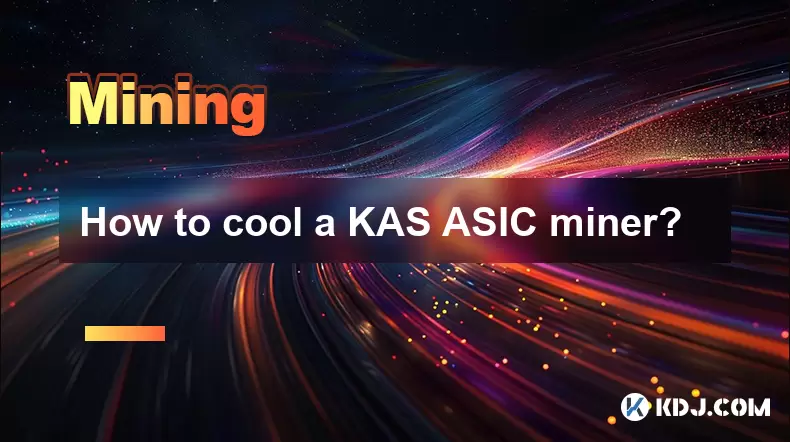-
 bitcoin
bitcoin $122659.385674 USD
0.52% -
 ethereum
ethereum $4484.113342 USD
-0.09% -
 bnb
bnb $1304.229256 USD
-0.85% -
 tether
tether $1.000204 USD
-0.03% -
 xrp
xrp $2.860636 USD
-0.51% -
 solana
solana $227.288799 USD
2.36% -
 usd-coin
usd-coin $0.999805 USD
0.01% -
 dogecoin
dogecoin $0.252837 USD
1.18% -
 tron
tron $0.341149 USD
1.12% -
 cardano
cardano $0.830507 USD
0.33% -
 hyperliquid
hyperliquid $45.792319 USD
0.04% -
 chainlink
chainlink $22.422164 USD
1.55% -
 ethena-usde
ethena-usde $1.000283 USD
0.01% -
 sui
sui $3.511389 USD
0.83% -
 stellar
stellar $0.385276 USD
-0.44%
How to cool a KAS ASIC miner?
Proper cooling is crucial for KAS ASIC miners to prevent overheating, maintain performance, and extend hardware lifespan.
Jul 24, 2025 at 03:00 pm

Understanding the Importance of Cooling in KAS ASIC Miners
Proper cooling is essential for maintaining the performance and longevity of a KAS ASIC miner. These mining devices operate at high computational loads, generating significant heat due to continuous processing. Without adequate cooling, the internal components—especially the ASIC chips—can overheat, leading to thermal throttling, reduced hashrate, or even permanent hardware damage. The goal of cooling is not only to prevent overheating but also to ensure stable operation over extended periods. Since KAS miners are designed for efficiency, any deviation in temperature can directly affect mining output and energy consumption ratios.
Optimal Placement and Ventilation Setup
The physical location of your KAS ASIC miner plays a critical role in its ability to dissipate heat. It should be placed in a well-ventilated area with unrestricted airflow. Avoid placing the miner near walls, enclosed cabinets, or other heat-emitting devices. Ensure there is at least 30 cm of clearance on all sides, especially the intake and exhaust vents. Position the miner so that its exhaust faces an open space or is directed toward a window or exhaust duct. If possible, install the device in a dedicated mining room with active airflow management. Use ceiling fans or industrial-grade blowers to promote air circulation and prevent hot air from pooling around the machine.
- Place the miner on a flat, non-flammable surface
- Avoid carpeted or fabric-covered floors that restrict airflow
- Keep the surrounding area free of dust and debris
- Monitor ambient room temperature—ideally below 28°C
Using External Cooling Solutions
While KAS ASIC miners come with built-in fans, these may not be sufficient under high-load conditions or in warmer environments. Supplementing with external cooling solutions can significantly improve thermal performance. One effective method is installing auxiliary fans near the miner to increase airflow across its surface. These fans should be positioned to create a directed airflow from the intake to the exhaust side.
Another option is using air conditioning units specifically for the mining area. Portable or split-type AC units can maintain a stable ambient temperature. For large-scale operations, consider setting up a ducted cooling system that pulls hot air away from the equipment and replaces it with cooled air. Some miners also benefit from heat shields or deflectors that guide hot exhaust away from sensitive components.
- Use high-CFM (cubic feet per minute) fans for better airflow
- Install temperature-controlled fan controllers to adjust speed based on heat output
- Consider evaporative coolers in dry climates as an energy-efficient alternative
- Avoid placing fans directly on top of the miner unless designed for vertical airflow
Regular Maintenance for Efficient Heat Dissipation
Dust accumulation is a major contributor to overheating in ASIC miners. Over time, dust clogs the air filters, heatsinks, and internal fans, reducing their ability to transfer and expel heat. A maintenance schedule should be established to clean the miner at least once every two weeks in dusty environments.
To clean your KAS ASIC miner:
- Power off and unplug the device completely
- Use compressed air to blow dust from the heatsinks, fan blades, and ventilation grilles
- Remove any visible dust buildup with a soft brush or anti-static cloth
- Inspect the internal fans for wobbling or unusual noise, which may indicate wear
- Replace air filters if the model includes them
Additionally, check that all fans are spinning at their rated speeds. Use the miner’s web interface or control software to monitor fan RPM and internal temperature. Any deviation from normal readings could indicate a cooling issue that needs immediate attention.
Monitoring and Adjusting Temperature in Real Time
Modern KAS ASIC miners provide real-time temperature monitoring through their built-in dashboard or API. Accessing this data allows you to respond proactively to rising temperatures. Log into the miner’s IP address via a web browser to view current stats, including chip temperature, fan speed, and hashrate.
If temperatures exceed 75°C, consider adjusting the fan curve or reducing the miner’s power limit. Some firmware versions allow you to customize fan behavior based on temperature thresholds. Increasing fan speed can lower chip temperature, though it may result in higher noise levels.
- Set up alerts for temperature spikes using third-party monitoring tools
- Use software like Awesome Miner or Hive OS to track multiple devices
- Adjust voltage settings to reduce heat output without significantly impacting efficiency
- Reboot the miner periodically to clear any thermal memory buildup in the system
Advanced Cooling Techniques for High-Density Setups
In environments with multiple KAS ASIC miners, passive cooling may not suffice. Immersion cooling is an advanced technique where the entire miner is submerged in a non-conductive liquid that absorbs and transfers heat efficiently. While this method is costly and complex, it eliminates dust and dramatically reduces noise.
Alternatively, custom ducting systems can be built using insulated aluminum or PVC pipes to channel hot air outside the building. Pair this with intake filters to prevent dust from entering the miner. Some operators install water-cooled heat exchangers near exhaust points to cool outgoing air before it re-enters the room.
- Use thermal paste replacement on ASIC chips every 6–12 months for better heat transfer
- Install temperature sensors near critical components for granular monitoring
- Consider rack-mounted setups with integrated cooling zones
- Avoid overclocking unless additional cooling infrastructure is in place
Frequently Asked Questions
Can I use a household fan to cool my KAS ASIC miner?Yes, a household fan can help improve airflow around the miner, especially if placed to blow air across the intake side. However, standard fans lack the CFM and durability of industrial models. For consistent results, use fans rated for continuous operation and position them to avoid creating turbulent airflow.
What is the ideal operating temperature for a KAS ASIC miner?The ideal chip temperature range is between 50°C and 70°C. Temperatures above 80°C are considered risky and may trigger automatic shutdowns. Ambient room temperature should remain below 28°C to support efficient cooling.
Is it safe to mine in a garage or outdoor shed?Mining in a garage or shed is possible if the environment is controlled. Protect the miner from moisture, dust, and extreme temperatures. Use weatherproof enclosures if necessary, and ensure electrical wiring can handle the load. Avoid locations with high humidity or temperature fluctuations.
How often should I check the miner’s cooling system?Inspect the cooling system weekly for dust buildup, fan performance, and abnormal noises. Perform a full cleaning every two weeks in dusty areas. Monitor temperature logs daily to detect early signs of cooling inefficiency.
Disclaimer:info@kdj.com
The information provided is not trading advice. kdj.com does not assume any responsibility for any investments made based on the information provided in this article. Cryptocurrencies are highly volatile and it is highly recommended that you invest with caution after thorough research!
If you believe that the content used on this website infringes your copyright, please contact us immediately (info@kdj.com) and we will delete it promptly.
- Binance Alpha's AB Token Crash: A Cautionary Tale in Cryptocurrency
- 2025-10-09 20:45:17
- Crypto ETFs, Altcoins, and Wall Street: Navigating the New Frontier
- 2025-10-09 20:45:17
- Bitcoin's Decade of Dominance: A Super Reason to Hold for the Next 10 Years?
- 2025-10-09 20:25:15
- FUN Token, SportFun Network, and Football Fun: A Winning Play in the Crypto Game?
- 2025-10-09 20:50:11
- Joke's On You, Copyright Thieves: Datavault AI's Joke Token Revolutionizes Comedy
- 2025-10-09 20:50:11
- Joke Token, Copyright Protection, and Datavault AI: A New Era for Comedy?
- 2025-10-09 20:55:11
Related knowledge

The difference between staking and mining
Sep 24,2025 at 05:18am
Understanding Staking in the Cryptocurrency Ecosystem1. Staking involves holding funds in a cryptocurrency wallet to support the operations of a block...

How to participate in testnet mining?
Sep 22,2025 at 09:18am
Understanding Testnet Mining in the Crypto Ecosystem1. Testnet mining is a method used by blockchain developers to simulate real-world conditions on a...

How to dispose of abandoned mining machines?
Sep 19,2025 at 08:19pm
Assessing the Condition of Abandoned Mining Rigs1. Begin by inspecting each mining machine for visible damage, corrosion, or missing components. Machi...

How to identify high-quality mining pools?
Sep 21,2025 at 03:19pm
Reputation and Track Record1. A mining pool’s reputation is built over time through consistent performance and transparency. Pools that have operated ...

Advantages of decentralized mining pools
Sep 20,2025 at 04:36pm
Enhanced Security and Resistance to Censorship1. Decentralized mining pools operate on blockchain-based smart contracts, eliminating the need for a ce...

What is mining machine overclocking?
Sep 21,2025 at 07:19pm
Understanding Mining Machine Overclocking1. Mining machine overclocking refers to the process of increasing the operating frequency of a cryptocurrenc...

The difference between staking and mining
Sep 24,2025 at 05:18am
Understanding Staking in the Cryptocurrency Ecosystem1. Staking involves holding funds in a cryptocurrency wallet to support the operations of a block...

How to participate in testnet mining?
Sep 22,2025 at 09:18am
Understanding Testnet Mining in the Crypto Ecosystem1. Testnet mining is a method used by blockchain developers to simulate real-world conditions on a...

How to dispose of abandoned mining machines?
Sep 19,2025 at 08:19pm
Assessing the Condition of Abandoned Mining Rigs1. Begin by inspecting each mining machine for visible damage, corrosion, or missing components. Machi...

How to identify high-quality mining pools?
Sep 21,2025 at 03:19pm
Reputation and Track Record1. A mining pool’s reputation is built over time through consistent performance and transparency. Pools that have operated ...

Advantages of decentralized mining pools
Sep 20,2025 at 04:36pm
Enhanced Security and Resistance to Censorship1. Decentralized mining pools operate on blockchain-based smart contracts, eliminating the need for a ce...

What is mining machine overclocking?
Sep 21,2025 at 07:19pm
Understanding Mining Machine Overclocking1. Mining machine overclocking refers to the process of increasing the operating frequency of a cryptocurrenc...
See all articles


























![🚨IS VECHAIN (VET) A DEAD COIN ?? PRICE ANALYSIS [GET READY NOW] 🚨IS VECHAIN (VET) A DEAD COIN ?? PRICE ANALYSIS [GET READY NOW]](/uploads/2025/10/09/cryptocurrencies-news/videos/vechain-vet-dead-coin-price-analysis-ready/68e7b200b067b_image_500_375.webp)















































